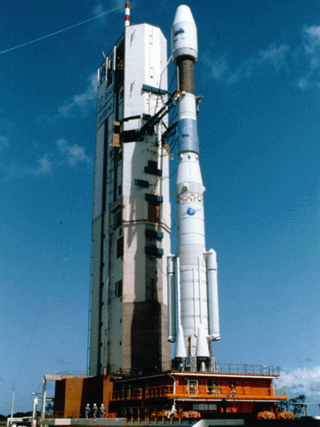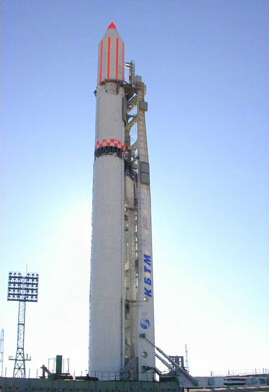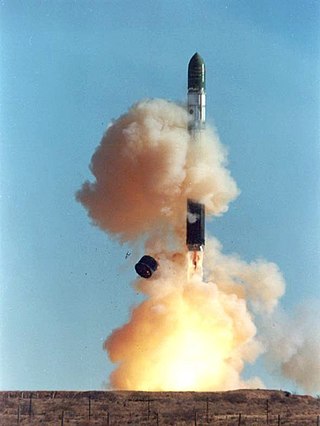
The Ariane 4 was a European expendable launch vehicle,developed by the Centre national d'études spatiales (CNES),the French space agency,for the European Space Agency (ESA). It was manufactured by ArianeGroup and marketed by Arianespace. Since its first flight on 15 June 1988 until the final flight on 15 February 2003,it attained 113 successful launches out of 116 total launches.
Pivdenne Design Office,located in Dnipro,Ukraine,is a designer of satellites and rockets,and formerly of Soviet intercontinental ballistic missiles (ICBMs),established by Mikhail Yangel. During the Soviet era the bureau's OKB designation was OKB-586.

Zenit is a family of space launch vehicles designed by the Yuzhnoye Design Bureau in Dnipro,Ukraine,which was then part of the Soviet Union. Zenit was originally built in the 1980s for two purposes:as a liquid rocket booster for the Energia rocket and,equipped with a second stage,as a stand-alone middle-weight launcher with a payload greater than the 7 tonnes of the Soyuz but smaller than the 20 tonnes payload of the Proton. The last rocket family developed in the USSR,the Zenit was intended as an eventual replacement for the dated Soyuz and Proton families,and it would employ propellants which were safer and less toxic than the Proton's nitrogen tetroxide/UDMH mix. Zenit was planned to take over crewed spaceship launches from Soyuz,but these plans were abandoned after the dissolution of the Soviet Union in 1991.
The Tsyklon,GRAU index 11K67,was a Soviet-designed expendable launch system,primarily used to put Cosmos satellites into low Earth orbit. It is based on the R-36 intercontinental ballistic missile designed by Mikhail Yangel and made eight launches,with seven successes and one failure. All of its launches were conducted from LC-90 at the Baikonur Cosmodrome. It is sometimes designated Tsyklon-2A,not to be confused with the later Tsyklon-2 rocket. It was introduced in 1967 and was derived from the R-36 ICBM. It was retired in 1969.

The Angara rocket family is a family of launch vehicles being developed by the Moscow-based Khrunichev State Research and Production Space Center. The launch vehicles are to put between 3,800 kg (8,400 lb) and 24,500 kg (54,000 lb) into low Earth orbit and are intended,along with Soyuz-2 variants,to replace several existing launch vehicles.

The R-36 is a family of intercontinental ballistic missiles (ICBMs) and space launch vehicles (Tsyklon) designed by the Soviet Union during the Cold War. The original R-36 was deployed under the GRAU index 8K67 and was given the NATO reporting name SS-9 Scarp. It was able to carry three warheads and was the first Soviet MRV missile. The later version,the R-36M, also known as RS20, was produced under the GRAU designations 15A14 and 15A18 and was given the NATO reporting name SS-18 Satan. This missile was viewed by certain United States analysts as giving the Soviet Union first strike advantage over the U.S.,particularly because of its rapid silo-reload ability,very heavy throw weight and extremely large number of re-entry vehicles. Some versions of the R-36M were deployed with 10 warheads and up to 40 penetration aids and the missile's high throw-weight made it theoretically capable of carrying more warheads or penetration aids. Contemporary U.S. missiles,such as the Minuteman III,carried up to three warheads at most.

The State Space Agency of Ukraine is the Ukrainian government agency responsible for space policy and programs. Along with the Ukrainian Defense Industry and the Antonov Aeronautical Scientific-Technical Complex,it is a major state complex of the national defense industry of Ukraine.The agency was formed in 1992 based on the Soviet space program infrastructure remaining in Ukraine following the dissolution of the Soviet Union.
The RD-8 is a Soviet / Ukrainian liquid propellant rocket engine burning LOX and RG-1 in an oxidizer rich staged combustion cycle. It has a four combustion chambers that provide thrust vector control by gimbaling each of the nozzles in a single axis ±33°. It was designed in Dnipropetrovsk by the Yuzhnoye Design Bureau as the vernier thruster of the Zenit second stage. As such,it has always been paired with the RD-120 engine for main propulsion.

The Atlas III was an American orbital launch vehicle,used in the years between 2000 and 2005. It was developed from the highly successful Atlas II rocket and shared many components. It was the first member of the Atlas family since the Atlas A to feature a "normal" staging method,compared to the previous Atlas family members,which were equipped with two jettisonable outboard engines on the first (booster) stage. The Atlas III was developed further to create the Atlas V.

The RT-20P was an experimental intercontinental ballistic missile (ICBM) developed but not deployed by the Soviet Union during the Cold War. The control system for it was designed at NPO "Electropribor". It was assigned the NATO reporting name SS-15 Scrooge and carried the GRAU index 8K99. The RT-20 was the first mobile ICBM designed by the Soviet Union. Its launch platform was based on the T-10 tank.

This comparison of orbital launch systems lists the attributes of all individual rocket configurations designed to reach orbit. A first list contains rockets that are operational or in development as of 2023;a second list includes all upcoming rockets and a third list includes all retired rockets For the simple list of all conventional launcher families,see:Comparison of orbital launchers families. For the list of predominantly solid-fueled orbital launch systems,see:Comparison of solid-fueled orbital launch systems.

The Tsyklon-3,also known as Tsiklon-3 and Cyclone-3,GRAU index 11K68,was a Soviet,and subsequently Ukrainian orbital carrier rocket. Tsyklon 3 rocket body debris accounts for more than 500 pieces of space debris.
The RD-120 is a liquid upper stage rocket engine burning RG-1 and LOX in an oxidizer rich staged combustion cycle with an O/F ratio of 2.6. It is used in the second stage of the Zenit family of launch vehicles. It has a single,fixed combustion chamber and thus on the Zenit it is paired with the RD-8 vernier engine. The engine was developed from 1976 to 1985 by NPO Energomash with V.P. Radovsky leading the development. It is manufactured by,among others,Yuzhmash in Ukraine.
The RD-810 (РД-810) is a Ukrainian liquid propellant rocket engine burning LOX and Kerosene (RG-1) in a staged combustion cycle. It has a single combustion chamber that provides thrust vector control by gimbaling of the nozzle in two axis by +/- 8°. It is being designed in Ukraine by Yuzhnoye Design Bureau for the prospective first stage propulsion of the Mayak rocket family.
A medium-lift launch vehicle (MLV) is a rocket launch vehicle that is capable of lifting between 2,000 to 20,000 kg by NASA classification or between 5,000 to 20,000 kilograms by Russian classification of payload into low Earth orbit (LEO). An MLV is between small-lift launch vehicles and heavy-lift launch vehicles.
The RD-861 is a Soviet liquid propellant rocket engine burning UDMH and nitrogen tetroxide in a gas generator combustion cycle. It has a main combustion chamber,with four vernier nozzles fed by the gas generator output. It can be reignited a single time.
The RD-855 (GRAU Index 8D68M]),also known as the RD-68M,is a liquid-fueled rocket engine with four nozzles. As a vernier engine,it provides fine steering adjustments for rockets. It is powered by a combination of N2O4,an oxidizer,and UDMH,a propellant. This combination is hypergolic,meaning the two substances ignite on contact,eliminating the need for an external ignition source.
The RD-856 (GRAU Index 8D69M),also known as the RD-69M,is a four-nozzle liquid-fuel rocket vernier engine,burning N2O4 and UDMH in a gas generator cycle. It was used on the R-36,Tsyklon-2 and Tsyklon-3 second stage as thrust vector control by gimbaling of its nozzle. The engine is distributed through a cylindrical structure that is integrated around the main engine RD-252 module. The structure includes aerodynamic protection for the nozzles. The engine was started by a pyrotechnic ignitor.

Maritime Launch Services (MLS) is a Canadian space transport services company founded in 2016 and headquartered in Nova Scotia,Canada. MLS will rely on Ukrainian Cyclone-4M rockets by Pivdenne Design Office to launch polar and Sun-synchronous orbit from Canso,Nova Scotia. MLS is a joint venture of three U.S.-based firms.

The Cyclone-4M is a Ukrainian carrier rocket which is being developed for commercial satellite launches.












